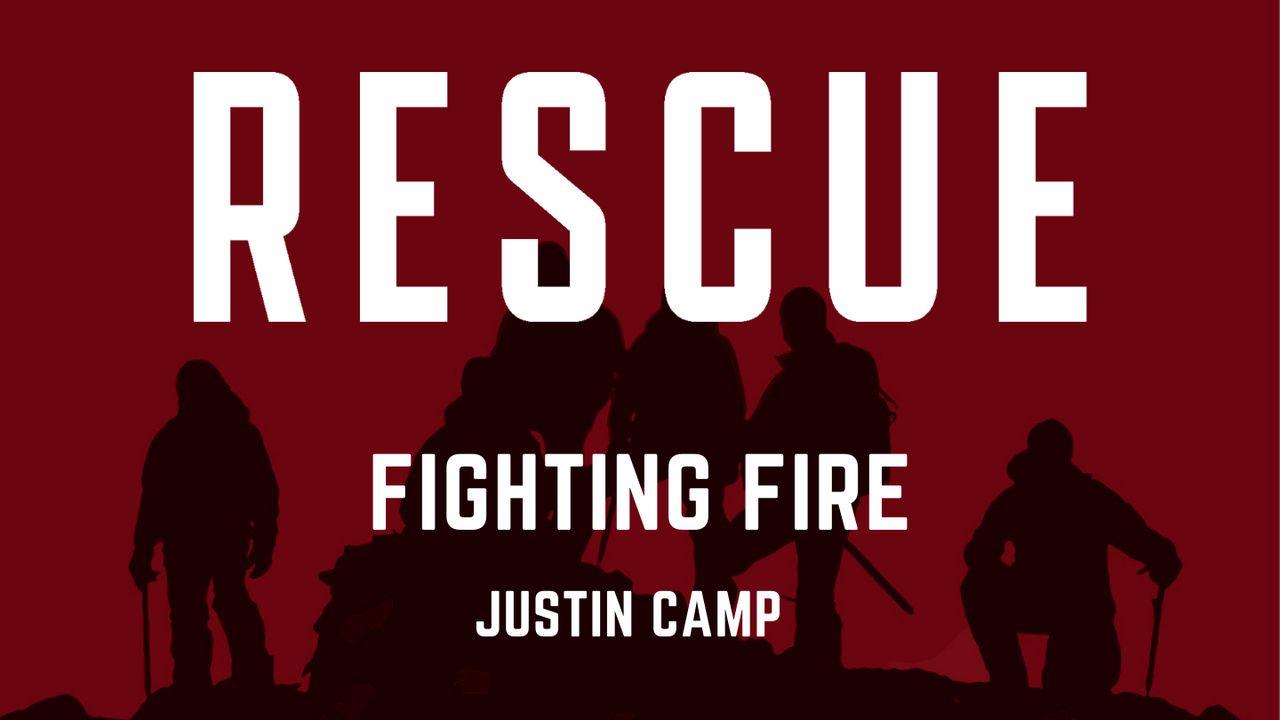Rescue: Fighting Fire by Justin CampSample

The Bridger Hotshots are in the middle of a roll—a blistering, fourteen-day stretch of sixteen-plus-hour days fighting a wildland fire. The crew is based in the Jackson Ranger District of the Bridger-Teton National Forest in Wyoming. Right now, though, they’re miles to the northeast, halfway across the state, the only hotshot crew fighting a medium-sized fire in the Bighorn National Forest.
What’s being called the Bucking Mule Fire was discovered in the Bucking Mule Falls area six days ago. Experts suspect that downed power lines started it. When the hotshots got assigned to it, the fire was less than a hundred acres in size. But it’s made some impressive runs recently and has now torn through more than forty-five hundred acres. The area is remote, full of steep mountains, deep gorges, and thick expanses of lodgepole pine.
Mountain pine beetles have aided this destruction. The beetles get under the bark of lodgepole pines and eventually kill them. These beetles have devastated forests in all nineteen western states and Canada, destroying more than ninety million acres with unbelievable kill rates. They’ve killed more than 90 percent of the lodgepoles in the Bucking Mule Falls area, leaving the hillsides and mountainsides full of dead, dry wood. Perfect fuel for forest fires. On top of that, hundreds of miles of power lines run through the area. And when those zombie trees fall, they sometimes break the lines, providing the spark needed to light all that kindling.
But that’s not all. Bighorn National Forest is currently under a red flag, a warning issued by the National Weather Service when weather conditions become ideal for wildland fires: when vegetation is dry, relative humidity is low, air temperatures are high, and winds are strong. The Bighorn has been under intermittent red flag warnings for much of the summer. Current gusts are up to fifty miles per hour.
The Bridger Hotspots have been fighting for days to contain the eastern edge of the Bucking Mule Fire. Weary from long, demanding shifts, it’s taking a lot of willpower for these guys to get out of their sleeping bags in the mornings. Today, though, the winds shifted, and the team has relocated to the north edge, where the fire is threatening a historic lodge and a set of cabins.
The hotshots arrived in the late morning in a billow of dust. When they showed up at the lodge, two smokejumpers were already there leading the charge, along with two Forest Service engine crews. They had been working on getting everything in place before the fire arrived—laying hoses and getting sprinklers and pumps set—all to protect the main structure and surrounding cabins.
Aaron Wright, superintendent of the Bridger Hotshots, has reunited with Bill Torres, an old friend and one of the most experienced smokejumpers in the Forest Service.
Wright notices a man standing at a distance and not in uniform.
One of the engine captains explains that the man is the lodge’s caretaker. “His name is Kyle Turner,” the captain says. “He grew up here, and he’s decided to defy our evacuation order. He was here when we got here, handling those garden hoses. He’s a good dude. He and his wife and their two young daughters live in one of them cabins.”
Wright and Torres approach nineteen other men gathered around the ten-person crew-carrier trucks, which they call “the buggies.” The guys are talking in hushed tones, preparing for battle. Pulling tools and gear out of the vehicles. Topping up fuel and oil for the chainsaws. Checking backpacks. Filling water bottles. Chugging water.
“All right, gentlemen,” Wright says. “Some of you know Bill Torres. He’s one of the finest jumpers in the Forest Service. He and I think this fire is coming this way and fast. And these are historic buildings, which we want to keep from burning. But here’s something else: the guy setting up hoses over there is named Kyle. He and his wife live here with their two daughters, aged eight and eleven. That’s their cabin right over there. He could have evacuated. He definitely should have evacuated.”
Laughter ripples through the men at this.
“But,” Wright continues, “we’re gonna help this dad save his family’s home.”
The men answer with another ripple of “uh-huh” and “yes, sir” and “yeah, Supe.”
Wright nods. “As you guys know, this fire of ours has plenty of fuel and wind. It’s been crowning every day since we’ve been here, so there’s no way we’re going to hold it here. So we’re not going to worry about that right now. We’ll chase her down later. What we are going to worry about is saving these structures. It’s going to be close, but I think we can get it done.”
Wright explains the plan to do a burnout to deprive the fire of fuel around the structures. The hotshots look from their beloved leader to the mountain. An eighty-foot-thick carpet of dead trees covers the slope from base to ridge. However, this thing turns out, it’s going to be quite a show.
“Let’s get to work.”
Questions to Ponder
1. What’s the most dangerous fire you’ve ever encountered?
2. Under what conditions would you think about refusing an evacuation order?
3. What qualities does it take to be a good firefighter?
About this Plan

In Rescue, Justin Camp reminds guys that God put his Spirit into their hearts so they would come out of isolation and support and sacrifice for one another. Read how this happens in real life in the stories shared here and reflect on your responses if you had similar experiences.
More
We would like to thank David C Cook for providing this plan. For more information, please visit: https://shop.davidccook.org/









